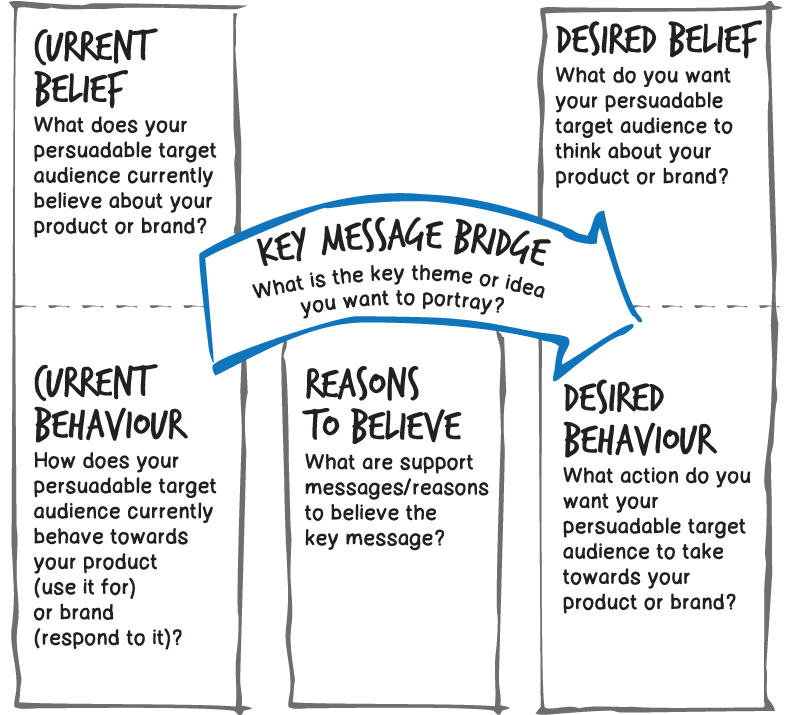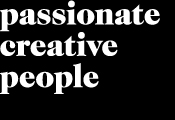Creating meaningful key messaging that truly resonates.
It might seem like a simple task, but you'll see as you work though the steps, that narrowing things down to one targeted customer belief, behaviour, and a final key messaging that truly resonates with your customers can be a difficult task.
What are we getting at here? Machteld Faas Xander uses a little tool called the Communication Bridge™ to organize and create meaningful, targeted key messaging that customers really resonate with.
What is the Communication Bridge?
The Communication Bridge is a tool that focuses on the 'power of one' by organizing a single idea into four boxes with a key messaging bridge and supporting messaging box that link the two together. It might seem like a simple task—but it can take hours to really drill down to a meaningful key message that's able to persuade your target audience. But first, you need to nail down a persuadable audience that you want to target. This solid foundation will help you use the Communication Bridge to develop one, strong key message that truly speaks to your target demographic.
The Communication Bridge is laid out and filled in like so:

How to fill in your own Communication Bridge
Just follow these seven steps:
Step 1.
Determine your persuadable target audience:
Start by determining your persuadable target audience. All of the information in the boxes will relate to this specific group. It's ok to get very specific, in fact, it's encouraged. The thing to remember is that although the key message will be aimed directly at this group; it will also be relevant to outlying customer groups, it just won't be as relevant to their situation as it will be to the persuadable target audience.
Remember, the key word here is 'persuadable'. For instance, you could aim your messaging at:
- A segment of new customers to your industry
- A segment of competitive users that are unhappy with existing products/services
- Those who only recently become competitive customers and aren't completely sold on the competition's product or services
Step 2.
Determine current belief:
Once you've decided on your Persuadable Target Audience, you'll want to set up your workspace in an open visual space. A whiteboard (you know we love 'em) is perfect if you're working with a large group. Start by brainstorming around your Persuadable Target Audience's current belief (in the top box, on the far left) and perceptions. Ask: "What do they currently hear, think, see, say, feel and believe (even though it might be untrue) about your product or brand?" You might even want to start with an Empathy Map (I promise to explain this tool in our next issue) to really nail your target audience down. Again, the key is to narrow it down to one core belief that you want to change or strengthen with your communications.
Step 3.
Determine desired belief:
Next, list the one desired belief that will challenge or change the current belief (in the top, far right box). If a current belief is positive, you might list a desired belief that reinforces or strengthens this exist perception. In other words, ask yourself: What do you want your target market to believe at the end of the communication?
Step 4.
Determine current behaviour:
For current behaviour, you'll use the box on the bottom left. Fill in this box with an action that the audience uses or performs with regards to your product. Like the current belief, you want just one current behaviour that links back to the belief in a relevant way.
Step 5.
Determine desired behaviour:
Next, identify the one desired behaviour (in the far right, bottom box) that you want your target audience to perform with regards to your product.
Step 6.
Determine key message:
Finally, one (yes, only one) over-encompassing key message will emerge (and appear in the upper, middle, arrow-shaped bridge). Again, it can only be one, concise statement that all others strive towards or support. And believe us when we tell you that you'll know when you've nailed it. We can't really describe the "eureka" feeling, but you'll know instantly when you have it right … you just have to experience it for yourself! After arriving at the key message, any related messages that spring off can be used to fill in the "reasons to believe" box.
Step 7.
Determine reasons to believe:
Once you've narrowed down an overall key message, you'll start to pin point what we like to call "reasons to believe'—or messages that support the desired behaviour (in the middle, bottom box). Think of this box as the solid foundation for your key messaging bridge. It should capture messages that support your key message, and in turn, the desired behaviour and belief as well. You should limit this box to 3 'reasons to believe' in total.
Testing, testing
Well, that sounds pretty easy, right? Not so fast! As you work through the process, you'll start to realize that although it appears simple; it can take awhile to narrow down one point for each box. It's also not uncommon to change or update your beliefs and behaviours, and even your persuadable target audience, as you go. This refinement will make for a stronger Communication Bridge in the end.
OK, now it's your turn. Give the Communication Bridge a whirl at your own company. Please, let us know if you have any questions—and let us know how it works out as an effective key messaging tool within your organization.
Interested in exploring Design Thinking further?
The Communication Bridge, like all of the other tools we use in-house at MFX, is inspired by our Design Thinking process—one that blends creative problem-solving (left brain) with analytical (right brain) thinking, and challenges each and every one of us to play the role of influencer rather than director when it comes to innovation.
Interested in exploring Design Thinking further? Well then join us on June 20, 2011, from 9 AM to 5 PM, for a full-day Design Thinking Basics Workshop at our office. Anyone—from business leaders to influencers of any kind will benefit. The only thing you need to bring is your enthusiasm and an open mind.


For Inquiries
Contact Alison De Muy
Phone: 519 576 6422 ext. 116
Email: alison@machteldfaasxander.com
Website: machteldfaasxander.com
